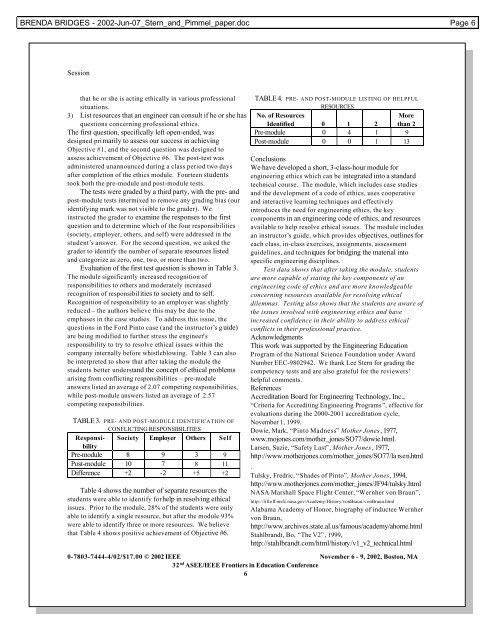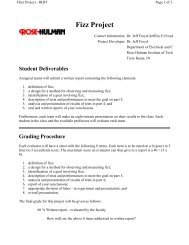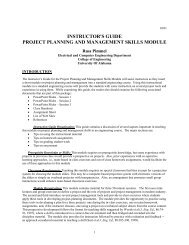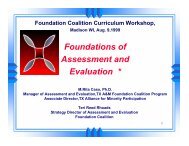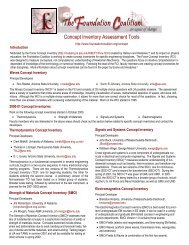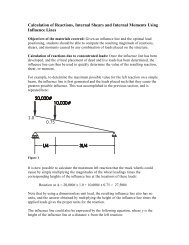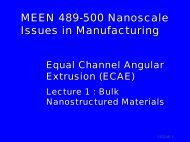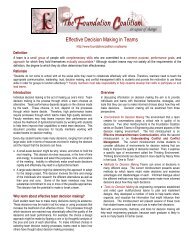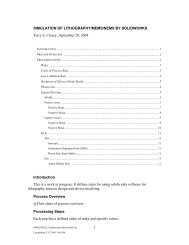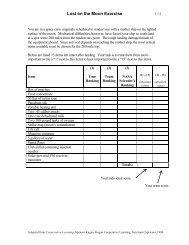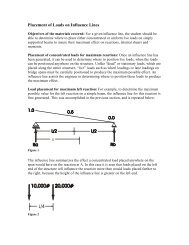Paper - Foundation Coalition
Paper - Foundation Coalition
Paper - Foundation Coalition
Create successful ePaper yourself
Turn your PDF publications into a flip-book with our unique Google optimized e-Paper software.
BRENDA BRIDGES - 2002-Jun-07_Stern_and_Pimmel_paper.doc Page 6<br />
Session<br />
that he or she is acting ethically in various professional<br />
situations.<br />
3) List resources that an engineer can consult if he or she has<br />
questions concerning professional ethics.<br />
The first question, specifically left open-ended, was<br />
designed primarily to assess our success in achieving<br />
Objective #1, and the second question was designed to<br />
assess achievement of Objective #6. The post-test was<br />
administered unannounced during a class period two days<br />
after completion of the ethics module. Fourteen students<br />
took both the pre-module and post-module tests.<br />
The tests were graded by a third party, with the pre- and<br />
post-module tests intermixed to remove any grading bias (our<br />
identifying mark was not visible to the grader). We<br />
instructed the grader to examine the responses to the first<br />
question and to determine which of the four responsibilities<br />
(society, employer, others, and self) were addressed in the<br />
student’s answer. For the second question, we asked the<br />
grader to identify the number of separate resources listed<br />
and categorize as zero, one, two, or more than two.<br />
Evaluation of the first test question is shown in Table 3.<br />
The module significantly increased recognition of<br />
responsibilities to others and moderately increased<br />
recognition of responsibilities to society and to self.<br />
Recognition of responsibility to an employer was slightly<br />
reduced – the authors believe this may be due to the<br />
emphases in the case studies. To address this issue, the<br />
questions in the Ford Pinto case (and the instructor’s guide)<br />
are being modified to further stress the engineer’s<br />
responsibility to try to resolve ethical issues within the<br />
company internally before whistleblowing. Table 3 can also<br />
be interpreted to show that after taking the module the<br />
students better understand the concept of ethical problems<br />
arising from conflicting responsibilities – pre-module<br />
answers listed an average of 2.07 competing responsibilities,<br />
while post-module answers listed an average of 2.57<br />
competing responsibilities.<br />
TABLE 3. PRE- AND POST-MODULE IDENTIFICATION OF<br />
CONFLICTING RESPONSIBILITIES<br />
Responsibility<br />
Society Employer Others Self<br />
Pre-module 8 9 3 9<br />
Post-module 10 7 8 11<br />
Difference +2 -2 +5 +2<br />
Table 4 shows the number of separate resources the<br />
students were able to identify for help in resolving ethical<br />
issues. Prior to the module, 28% of the students were only<br />
able to identify a single resource, but after the module 93%<br />
were able to identify three or more resources. We believe<br />
that Table 4 shows positive achievement of Objective #6.<br />
TABLE 4. PRE- AND POST-MODULE LISTING OF HELPFUL<br />
RESOURCES<br />
No. of Resources<br />
More<br />
than 2<br />
Identified 0 1 2<br />
Pre-module 0 4 1 9<br />
Post-module 0 0 1 13<br />
Conclusions<br />
We have developed a short, 3-class-hour module for<br />
engineering ethics which can be integrated into a standard<br />
technical course. The module, which includes case studies<br />
and the development of a code of ethics, uses cooperative<br />
and interactive learning techniques and effectively<br />
introduces the need for engineering ethics, the key<br />
components in an engineering code of ethics, and resources<br />
available to help resolve ethical issues. The module includes<br />
an instructor’s guide, which provides objectives, outlines for<br />
each class, in-class exercises, assignments, assessment<br />
guidelines, and techniques for bridging the material into<br />
specific engineering disciplines.<br />
Test data shows that after taking the module, students<br />
are more capable of stating the key components of an<br />
engineering code of ethics and are more knowledgeable<br />
concerning resources available for resolving ethical<br />
dilemmas. Testing also shows that the students are aware of<br />
the issues involved with engineering ethics and have<br />
increased confidence in their ability to address ethical<br />
conflicts in their professional practice.<br />
Acknowledgments<br />
This work was supported by the Engineering Education<br />
Program of the National Science <strong>Foundation</strong> under Award<br />
Number EEC-9802942. We thank Lee Stern for grading the<br />
competency tests and are also grateful for the reviewers’<br />
helpful comments.<br />
References<br />
Accreditation Board for Engineering Technology, Inc.,<br />
“Criteria for Accrediting Engineering Programs”, effective for<br />
evaluations during the 2000-2001 accreditation cycle,<br />
November 1, 1999.<br />
Dowie, Mark, “Pinto Madness” Mother Jones, 1977,<br />
www.mojones.com/mother_jones/SO77/dowie.html.<br />
Larsen, Suzie, “Safety Last”, Mother Jones, 1977,<br />
http://www.motherjones.com/mother_jones/SO77/la rsen.html<br />
.<br />
Tulsky, Fredric, “Shades of Pinto”, Mother Jones, 1994,<br />
http://www.motherjones.com/mother_jones/JF94/tulsky.html<br />
NASA Marshall Space Flight Center, “Wernher von Braun”,<br />
http://liftoff.msfc.nasa.gov/Academy/History/vonBraun/vonBraun.html<br />
Alabama Academy of Honor, biography of inductee Wernher<br />
von Braun,<br />
http://www.archives.state.al.us/famous/academy/ahome.html<br />
Stahlbrandt, Bo, “The V2”, 1999,<br />
http://stahlbrandt.com/html/history/v1_v2_technical.html<br />
0-7803-7444-4/02/$17.00 © 2002 IEEE November 6 - 9, 2002, Boston, MA<br />
32 nd ASEE/IEEE Frontiers in Education Conference<br />
6


